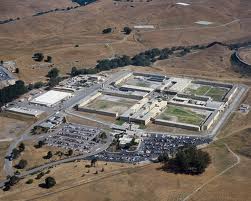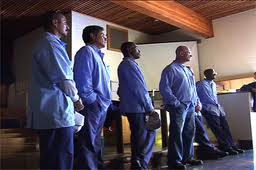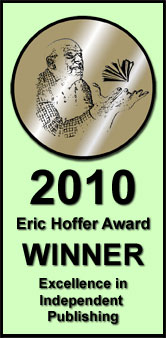The Emotional Anxiety of Prison Visitation
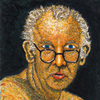
The California Men’s Colony is not a pleasant place to visit, and the authorities go out of their way to make you know it. A visit has all the charm of a stopover in a dank toilet room, but this toilet is a difficult place to enter. It took me more than five hours to get in to see my old friend, who has been there a long while. It felt as if I was a criminal trying to see a criminal, and in that feeling I am sure I am not alone. There is no amenity for family or friend of the convicted. In every way the prison system throws barriers at you. Prison visitation escalates emotional anxiety. I think it would be better to defuse the emotion than exacerbate it; however the system doesn’t appear to see it that way.
It starts when you first line up in the stream of cars at 7 a.m. — The time the prison information said to arrive — to get into the prison by 9 a.m. Nine is the time the official information states the institution will be open for visitors, but that time is not scrupulously adhered to. My wife and I joined the string of visitors in cars that formed a line on a dirt side road down the road from the entrance to the prison. There were no markers or signs stating that this was the place to wait, we learned when we drove onto the prison grounds and stopped to ask what we should do. A gruff uniformed man in a white truck labeled California Men’s Colony pointed to the side road about a half-mile away and said “Wait there until told you can enter.” We backtracked and got into line. We were about the 12th car in line, a line that gradually extended another 20 cars behind us. At about 8:15 the line of cars began to move out, drive down Route 1, and enter the main road leading to the prison.
We didn’t drive straight in toward the pale yellow complex in front of us. We turned left on a side road on the prison grounds, then turned right and formed another line that moved very slowly toward a group of prison officials who stopped and spoke to each car. After the stop the cars ahead of us either proceeded toward the large parking lot which fronted the prison or drove away and out of the prison. I wondered if they had been rejected for entry. When our turn came, the prison officials handed us an entry sheet that stated what our number for entrance was. Being first in line does not mean you get to be first to enter the prison. Entry is by lottery. We were numbers 37 and 38 despite the fact that we were the 12th car. I asked what we should do now? The prison official stated we could go park or return at 9 when entry would begin. I then asked the official if it would be OK to enter with our bicycles, which I had locked up in the back of my truck. You may have the bicycles in your truck, the official said, but they have to be locked to your truck. Mine weren’t. They were merely locked together. Ginger and I sped off back to our hotel to unload the bicycles before returning a little before 9. I wondered how prisoners were going to escape and steal locked up bikes. How much more protection would be afforded by the bikes being locked to the truck? It didn’t seem logical, but nothing seemed logical as the morning progressed.
Nine a.m. saw us standing with all the other visitors outside the entry door across a road in an concrete island which had no shade, only one small bench to sit upon, nor any pleasant vegetation. Everyone milled about. We asked what happens now? An elderly African-American woman told us that you waited until your group was called so you could line up across the street to the left of the prison entry. Lineup went by tens. There were no signs that indicated procedure. Numbers 1-10 were lined up against the wall. An official came out and told them they could enter. Once they disappeared inside, 11- 20 crossed the street and lined up in sequential number next to the pale yellow painted block wall. Twenty minutes later numbers 31- 40 were allowed to cross the street and form a queue. We dutifully lined up in positions 37 and 38. Fifteen minutes later we entered the receiving room for visitors, an ugly small room with a few chairs and hand-lettered signs telling you to line up before another doorway. On the wall next to that doorway was a poster with images stating what you could wear while visiting a prisoner. You can’t wear blue shirts or blue denim pants because this color will too closely resemble the clothing of the prisoners. No white over shirts. You can’t have underwire in your bra. (Inmates can do prohibited things with the wire.) You can’t wear green pants or tan shirts because these colors will too closely resemble the uniform of the guards. Now this was new. We already had two instruction sheets about visiting, and they each had some contradictions, but we had chosen our clothing to be perfectly compliant so we thought. I looked down at my pants. They were a greenish brown. The pants weren’t the same green as the prison guards’ pants so I thought I might be all right. My shirt was tan but had a bold tattersall design in blue, with wide crossing lines. Prison guard shirts were plain tan. I thought I might be all right. When my turn came to go through the doorway, I approached the desk where one official was operating and looking over all visitation papers. I had to furnish my driver’s license and fill out the top of the entry paper. It was all good. I thought I had made it in. As I stepped away from the counter toward the next stop, the inspection station, a guard stopped me. He said could not enter the prison because my pants were green and my shirt tan. I tried to argue that my clothes were different than his. The green pants were not the same color. The shirt was tan but had a distinct blue pattern. The guard was unmoved. I had to change my clothes. What was I supposed to do I asked? I don’t have other clothes with me. You’re lucky, the guard said, there is an alternative. I could follow all the other folks rejected for non-complying clothing (there were many) to “the yellow house,” where I could find some clothes that passed prison standard. Where was this building? The guard pointed outside beyond the parking lot. It’s over there by the construction sheds, he said. It wasn’t close. It was a fair distance away, back near the entry. I hastily returned to my truck and drove quickly to the yellow building near several construction trailers a quarter-mile away. I was beginning to fume.
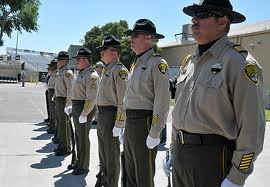 The yellow house is a facility set up by “Friends Outside,” a non-profit group started to help family of prisoners. While I waited here for the changing room to become free, Ginger arrived having walked all the way to the yellow house after seeing me speed away. She too had been rejected. She had on two layers of blouse, a no-no that had not been mentioned on the instruction sheets. I slipped into an ill-fitting pair of black pants with no belt and a black sweatshirt, both faded from many washings. Ginger put on a red knit shirt. Our clothes were locked in a closet until our return. We headed back.
The yellow house is a facility set up by “Friends Outside,” a non-profit group started to help family of prisoners. While I waited here for the changing room to become free, Ginger arrived having walked all the way to the yellow house after seeing me speed away. She too had been rejected. She had on two layers of blouse, a no-no that had not been mentioned on the instruction sheets. I slipped into an ill-fitting pair of black pants with no belt and a black sweatshirt, both faded from many washings. Ginger put on a red knit shirt. Our clothes were locked in a closet until our return. We headed back.
The time was pushing 10 a.m. We joined a line much like the line at the airport to have our possessions scrutinized. Ginger went first. She took off her shoes and put them on a serving tray like you find in cafeterias, along with a $30 bag of quarters, which prison visitors are allowed to bring for use to buy lunch and snacks for themselves and the prisoner in the vending machines in the visiting area. (Another instruction sheet given us later said we could have brought in $50 apiece and that dollar bills were also acceptable.) A guard inspected her shoes and handed them back. She was approved to move onto the next stage. I removed my shoes, placed my car key on the tray. My wallet I locked in the car. My loose pants nearly fell to my knees. Where is your driver’s license, the inspection guard asked? It’s in my car with my wallet, I replied. You’ve looked at all ready. What do I need it for now? You have to have your license with you at all times, the guard stated. Where is that written I asked? The guard replied only you have to have your license with you at all times. This is 3 I mumbled to myself as I raced back to the truck to get my driver’s license. First the bicycles, second the clothes, and now the drivers license. These officials are really poor communicators, or they just don’t give a damn.
I rushed back with the license, and stood in the inspection line again with my shoes, my truck key, my entry form and my driver’s license on the inspection tray. Everything was approved and I moved up to the next desk where I lay my visitation paper with my number 38 on it along with my driver’s license. A guard had already reviewed Ginger’s paper and license and waved her through the metal detector portal. She was in. The guard departed and I stood there waiting while two guards carried on a long conversation. Finally one came and picked up my license and paper. He eyed it and told me to walk through the scanner. The scanner buzzed. Had I still some metal hidden on my person the guard asked? No I replied, and went through the metal detector again. It buzzed. I said I know what it is I have a pacemaker in my chest, but the pacemaker no longer works. The guard questioned me, where is your doctor’s certificate for the pacemaker? No I don’t have one I replied. This requirement is not listed in your instruction pamphlet. Well you can’t get into the prison unless you have one, the guard stated. What was I supposed to do I asked? Come back another day with the doctor’s statement, or you could go to the medical clinic and get proof. Where is this clinic, I asked? Its back in San Louis Obispo at the second stop light on Meinecke Street, the guard said. I headed out. I was really fuming now. This was number 4 hassle. What was an inmate going to do rip my chest open and pull out the pacemaker? This was ridiculous.
I headed back to my car. We lowly visitors had to park at the far edge of the lot – employee parking is closest to the prison – and this was my third trip back to the vehicle. I am 67 years old, so this was getting hard to do physically. I finally found the clinic after driving all the way back to the center of San Luis Obispo. Meinecke wasn’t at the second stop light in San Luis Obispo. It wasn’t a major street, but a small side street two streets beyond the first stop light at the edge of town. Here I deduced that the medical clinic the guard had described was a family medical office. After parking badly as my temper was rising fast, I went in and joined the queue. I was told I would have a two-hour wait to see a doctor. Only one doctor was on duty on Saturday morning. I pleaded with them to see me sooner. In 40 minutes I was called and placed in a room where I nurse took my vital signs. I explained that all I needed was a doctor to write something that I have a non-operational pacemaker. The nurse said a doctor would be with me soon. I waited and I waited. I started to pace around the little examining room. From wall to wall I paced in three or four steps. My anxiety was growing steadily greater. I couldn’t take it in the closed door room. In my agitated state, the room felt like a prison cell I was sent to for being a bad visitor. I opened the door and began pacing up and down a small corridor and in and out of the room. A nurse came and offered me refreshment. I said I didn’t need refreshment. I needed a piece of paper that says I have a pacemaker in my chest not a bomb. I waited again. The doctor finally came and made a cursory examination. Where is the pacemaker he asked? I pointed to my upper left chest. He felt the site then dictated some information into his computer and filled out note on a prescription pad to say I have a pacemaker, and gave his telephone number. Two hours had passed. I had my piece of paper.
In a fury I drove back to the prison and slammed down the prescription paper on the counter. My arms were shaking I was so angry after four trips. The guards looked at me suspiciously. I realized I had to hold my temper or I would never get into prison. I refrained from making a snide comment. I was silent and the guard waved me around the metal detector. It was now afternoon. It had taken me over five hours to enter the California Men’s Colony.
After going through two more sets of gates, the last under the watchful gaze of an officer in a guard tower, I made my way to the visitor’s room where Ginger and our friend sat at a low table. I pulled up a chair sized, it seem, like a kindergarten chair at a kindergarten high table — you don’t want the visitors to be too comfortable, as they might want to stay — and I was able to visit with my friend until quarter of three when all the visitors were shooed out. Sixteen long years in prison had passed since I had last seen my friend in court. He was in better spirits than I. He is looking forward to parole in a few years. He says the California Men’s Colony is the best of prisons in the state. He has a single cell, and he is treated decently. He is healthy and has good medical and dental treatment. He hasn’t been raped. I, on the other hand, was full of resentment against the establishment. The prison had treated me like nuisance. I felt like I needed medical treatment after dealing with their rules. I felt like I had been raped by their system.
It took me a day or more for the bile to dissipate. Could it be that prison was better for the imprisoned than for the relatives, friends, and loved ones of the incarcerated? If you ask me, I would say my impression was true. Visiting prison made me an emotional basket case. I don’t know if I could ever be prepared enough mentally to go to visit a prison again. That is the way prison officials want it, I am sure.

